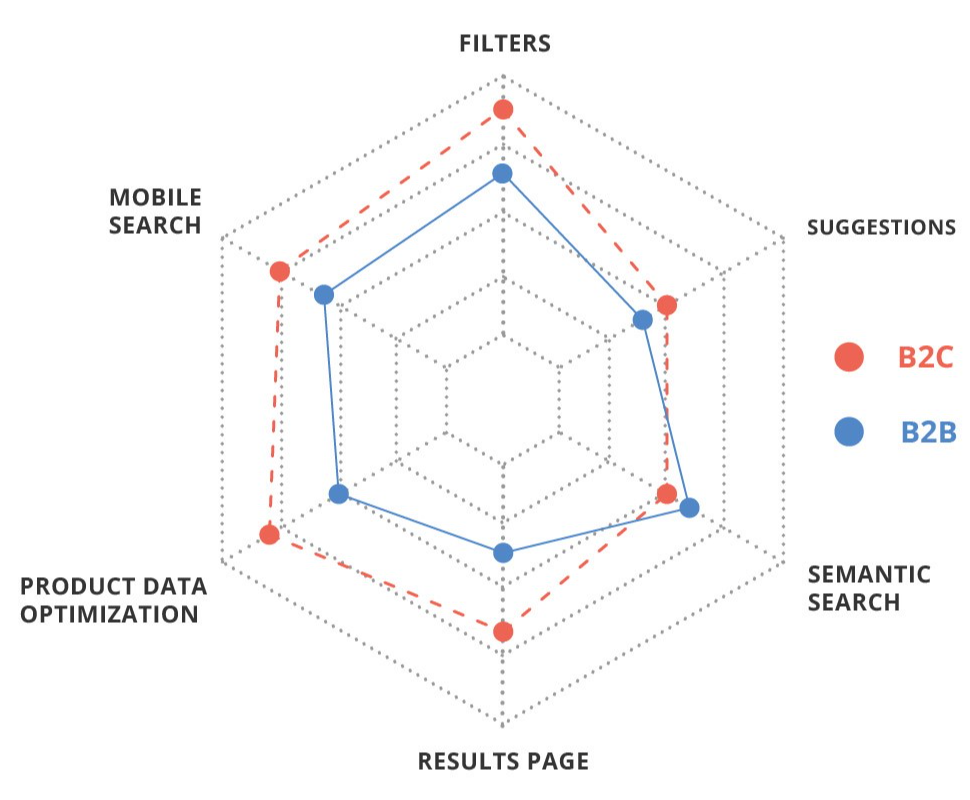Digital channels become increasingly relevant to customers which pushes B2B sellers to look towards improving their digital experience during the research and purchasing process. On top of the most important facets of an e-commerce website stands the site search, which is used to find products, listings, and other content within a seller’s website.
A recent study by Wunderman Thompson evaluated the onsite search function of 23 B2B e-commerce websites across 22 criteria. Those were then contrasted with eleven B2C e-commerce websites using the same methodology. Results show that B2B e-commerce sites rated much lower in those criteria when compared to B2C websites. In fact, the B2C shops scored 1.31x higher than the B2B shops. As the end-users are the same among both types of buyers, it is highly important that B2B sellers improve their on-site search features, at the risk of providing an unsatisfactory user experience for buyers.
These are the six search function clusters you need to improve now:
 Each of the displayed features contributes to a distinctive facet of search functionality. The scores in all but one of these clusters are inferior to their B2C counterparts. B2B sellers must therefore urgently improve features across all categories to secure a comprehensive user-anticipated experience.
Each of the displayed features contributes to a distinctive facet of search functionality. The scores in all but one of these clusters are inferior to their B2C counterparts. B2B sellers must therefore urgently improve features across all categories to secure a comprehensive user-anticipated experience.


What filters should an e-commerce platform offer?
When buying online the ability to narrow down choices from a large product range is key to making sure the offered products are the ones that best fit the buyers' needs. Those filters are usually well-implemented when it comes to B2C shops, as the high ratings within the filter cluster the B2C websites scored in the study show. Their B2B counterparts on the other hand were not up on that level. Most of the websites provided buyers with some sort of filtered search, however the execution of filter logic and functionality has been poor.
But what are good filters? One of the most important characteristics of a successful filtering system is the inclusiveness of most of the product selection within the filter options. Over 60% of the B2B websites that were evaluated had filters with options that returned less than a quarter of the initial search results. Ideally, filters should narrow down search results to show the user the most relevant products – not ignore certain listings entirely. A reason for products being excluded in that way could be improper tagging of items for the established filter choices. The clear goal for B2B sellers must be to avoid this issue with their search filter to provide a helpful, rather than obstructive filtering system to their customers.
What can I suggest to the buyer?
Another way to provide a successful on-site search is to improve search suggestions or autocomplete features. These help guide users to the products that best fit their needs. Search suggestions help to find items whose name might not fully be known to the customer, shows items with similar names and on top improve efficiency and speed when searching.
The study shows that most websites scored had simple search suggestions in place. Specific characteristics of strong suggestion functions were however missing on most of them. A clever way to improve the search experience is to place product images next to the suggestion. This can be especially useful for searchers who use search suggestions to better understand the search term that best fits their needs. A visual stimulus matching the customer’s idea of what they would like to purchase can be a simple yet immensely powerful addition to move a user much further in the buying process. This feature was missing from 74% of the examined websites.
An often-overlooked benefit of search suggestions is the call to action. For users who do have a concept in their mind already of what they would like to purchase, adding an “add to cart” or “add to favorites” next to the suggested product can make their online shopping experience more efficient.

How can I make my search engine smarter?
Considerably basic search engines return results based on exact matches to keywords in the query. However, customers might not always use the exact same wording to describe a product as the seller. A user might therefore search for a “mobile phone” with the intent of buying an item the seller has listed as a “cell phone”. If the search function is only able to return products with an exact keyword match, it will not be able to offer the correct listing. In result, the interested customer might abandon the site as he assumes the shop does not stock the product they are looking for.
Semantic search is the ability for a search engine to understand the meaning behind the words in the query. One of the most crucial factors in this cluster of criteria is synonym support which is used to support searching for synonyms to avoid the mentioned issue. Words that are used colloquially to refer to the same items should also return the same results. B2B e-commerce platforms often overlook this fundamental feature. 56% of the websites scored only returned results for searches that exactly match keywords in the product names or descriptions. A product that cannot be found is a product that cannot be purchased.

What results should I display?
In this cluster, the criteria include the presentation of products and information after a search is submitted. These features are for example the sorting of listings by multiple parameters, automatic redirects to categories or content, and the results of searches for non-product content.
In this cluster, the zero-results page is included as well, which provides guidance when the search function is unable to return any result. In the case of not being able to find any content that is relevant to the user, it can be frustrating and might push them to abandon the shop completely. As 90% of B2B customers scan 2-7 websites before purchasing a product, it is heavily important that zero-result pages always offer a way to move forward instead of providing reasons to switch to a competitor’s website. Zero-result pages can therefore be transformed into a helpful tool by offering search tips, category links, product suggestions, as well as customer support contact information. These simple additions can have a meaningful impact on the conversion rate, yet almost 80% of the B2B websites scored in the study did not offer sufficient zero-results experience. Those sellers put their customers at elevated risk for site abandonment should they make a search that does not return any results.
Result pages can also highlight non-product content results, which is another important but often overlooked aspect. This content can include information pages, such as return policies or account information, supplementary product information, such as manuals and safety documents, as well as marketing content, such as blog posts. The most apparent goal of e-commerce platforms is obviously to offer the products being sold; therefore, it is no surprise that product categories typically receive the prime navigation spots. This practice makes it easier for a buyer to find the products wanted but comes at the expense of access to non-product content. This content is then usually put into smaller, less visible sections of the page and may be difficult for users to find.
A compromise we offer is to support searches for non-product content. Buyers will then be able to easily search for the information they are looking for, and the aesthetic minimalism of navigation and landing pages does not suffer. Users even started expecting this feature on e-commerce sites. Usability testing shows that 34% of onsite searchers attempt to search for non-product content. A lot of B2B websites, however, fail to provide their users with such features. The study reveals that almost 40% of the B2B commerce sites scored have no ability to perform content searches at all. 
Why is mobile search indispensable?
Just as for their B2C counterpart, the B2B purchasing process is becoming increasingly mainstream, with 80% of B2B buyers using their mobile devices to research products. More than 60% report that being able to search mobile played a significant role in a recent purchase.
A well-built search function is often even more important on a mobile website, as smaller screens may make it more difficult for users to navigate the website. The research shows that 27% of the websites had underperforming mobile search experiences. It is vital that these sellers optimize the mobile site search to avoid missing opportunities with smartphone and tablet users. It must become common to offer the same optimized search features that are available on the desktop version, while modifying the interface to be user friendly on mobile devices as well. 
How can I optimize product data?
The criteria in the clusters mentioned thus far focused on the improvement of search functionality and experience. The completeness of the product data is just as important for a good search experience. Even the most stable search engine with every feature in place is not able to return results if the listing data is lacking. The product data optimization cluster encloses the criteria that play a role when ensuring that product data is exhaustive, so it does not hinder search user experience in any way.
Among the key factors of this category, especially when it comes to multinational B2B companies, is the localization feature. This feature refers to the process of adapting a website and its data to the correct language based on the region the user is in. For onsite search, this also means that product data must be fully translated into the correct language, so listings are not excluded from search results in case they contain data that is in a different language from the initial query. Of all websites from the study that presented their products to different localities in different languages, more than 65% had some sort of issue with the languages of their product date. Listings were therefore omitted because of the language mismatch. This presents a huge problem for international companies that needs to be addressed. Whole target markets might be unintentionally excluded from purchasing certain products offered.

How can I bring my e-commerce platform up to par?
Across all categories the site search of B2B e-commerce platforms is not up to par, especially when minding the rising expectations of their users. This is very problematic as those buyers already experience the high standards that are offered by B2C e-commerce platforms in their private life. The end users bring those experiences when judging the performance of the B2B platform and its site search.
The good news is that most of the missing or basic features can be introduced or extended easily. The biggest pain point is still that a lot of companies have not gone through a digital transformation yet, so the product data is either missing, inconsistent or not suitable for online purchase. Once the improvements are in place, they provide the platform a foundation it can build on in the future. More doors will then open and features like personalized search and product recommendations become interesting.
This whitepaper presents the great opportunity personalization offers to improve the buying experience and the conversion and customer satisfaction.







